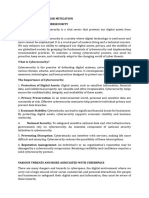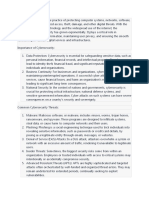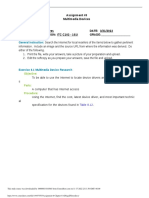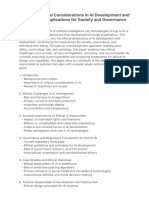0% found this document useful (0 votes)
26 views4 pagesReport On Data Security
This report emphasizes the importance of data security and cybersecurity for both individuals and organizations, outlining various types of personal and organizational data, the methods used by cybercriminals to exploit this data, and the implications of cyber warfare. It highlights best practices for protecting data, such as strong passwords, encryption, and employee training, while also addressing the consequences of security breaches and the different types of attackers. The document concludes that proactive measures and investments in cybersecurity are essential to mitigate risks and ensure data integrity.
Uploaded by
maynorsevilla91Copyright
© © All Rights Reserved
We take content rights seriously. If you suspect this is your content, claim it here.
Available Formats
Download as DOCX, PDF, TXT or read online on Scribd
0% found this document useful (0 votes)
26 views4 pagesReport On Data Security
This report emphasizes the importance of data security and cybersecurity for both individuals and organizations, outlining various types of personal and organizational data, the methods used by cybercriminals to exploit this data, and the implications of cyber warfare. It highlights best practices for protecting data, such as strong passwords, encryption, and employee training, while also addressing the consequences of security breaches and the different types of attackers. The document concludes that proactive measures and investments in cybersecurity are essential to mitigate risks and ensure data integrity.
Uploaded by
maynorsevilla91Copyright
© © All Rights Reserved
We take content rights seriously. If you suspect this is your content, claim it here.
Available Formats
Download as DOCX, PDF, TXT or read online on Scribd
/ 4























































































